Looking out from Old Paiwan Village, Calisi on the opposite hill and Old Pinghe to the North-west are most apparent. Both places are situated higher than Paiwan Village, therefore in Calisi one can clearly make out Paiwan Village on the slopes below. The same cannot be said for Old Pinghe, since it is behind the mountain, however on the way to Pinghe the village also becomes visible. The following are excellent accounts recorded by the students while investigating these two areas.
◎Records of Land Survey:
Looking back to Old Paiwan(2007,01/13)
Recorded by:Hsiao-jiang
It is Saturday morning and we are heading towards Old Paiwan Village, but we’re not investigating Old Paiwan Village today, we’re going to Calisi on the opposite mountain, which is my home. At about 900m above-sea-level it is roughly 80-100m higher than Old Paiwan. During the Japanese Occupation Period there were 26 families and the tribe was situated on a steep slope. My family has a big slabstone house there and we also own a herd of sheep, so we often go back to visit. My dad takes me to our old home about every 2 weeks, but this is my first time going back with teachers and students.
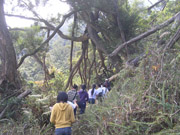
The motorcycle entered Old Paiwan and continued on the road to Taigulafa Waterfall. We rode downwards for about 20 minutes and parked the vehicle in the clearing next to Shelu Suspension Bridge. Why did we take motorcycles today? It’s because the teachers’ cars were not four-wheel drive and we were afraid that we might not be able to get back up after coming down. So we took our backpacks and crossed the bridge to go uphill. The path was clearly laid but the climb upwards quickly separated the strong from the weak – the fatigue was difficult to describe. Luckily the teacher kept an eye on us and after a few stops and nearly an hour of walking we arrived two hours later at our destination - Hsiao-Jiang’s house. Looking back to Old Paiwan we saw it below us on the opposite slope, and the Paiwan Cultural Hall being constructed could clearly be seen. I cannot help but admire the location picked out by the ancestors; its high position allowed invading enemies to be seen from every corner. We rested for an hour to look around, and descended down afterwards to end the day. What a tiresome investigation!
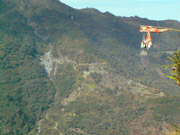
Forward to Old Pinghe (2007, 01/17)
Recorded by: Hsiao-yu
From the map Old Pinghe is shown be located south of Old Paiwan, but looking to the south from Old Paiwan we only knew it was behind the mountain. The teacher asked the village head, Uncle A-de, who knew its position well, and learnt that the road is not bad and could be travelled by a car. At halfway is a big parking lot where the cars could turn around and Pinghe would be in 40 minutes of walking distance. The teachers also searched for related information on the internet and decided to head out after our third evaluation today.
The teachers had prepared some bread and mineral water for lunch and it was already 11:30am when we arrived at Old Paiwan. The teacher asked the village head again to confirm road conditions and we sat out in our two cars immediately towards Old Pinghe. As soon as we left Paiwan, at the stone-wall the wheels of Supervisor Shih’s car began to slide, so everyone got out of the car to decrease the weight and we eventually passed smoothly. However the same occurred on the first stretch of uphill road and after backing up the car several times to try again we were still not successful, but with Supervisor Tsai’s help in clearing the road surface we finally passed through this second obstacle, though I was in the other car and we had no problems. We arrived at our destination screaming, since the bumpy road rocked the car sideways and up and down. Wah! Wow! What a big parking lot. You can imagine how big it was if the two cars took 20 minutes to back up. The expressions on the two driving supervisors showed their displeasure. Haha!
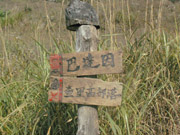
We then headed out with our lunches and drinking water. For those of you that can see the photos you would see how narrow the path was. We walked along Paiwan Old Trail and headed up. The weather was superb and showed clear blue sky and white clouds. After 3 bridges we entered the needle-leaf forest. The teacher told us that the leaves were so shaped due to sea-level. We also saw Hsiao-Jiang’s home in Calisi on the far slopes that were already below us.
After walking for a while our tummies began to complain, so we sat on the dried riverbed and did what we looked forward to the most – Lunch. The bread was so tasty that day and water especially sweet, since we were really hungry. After a short rest we continued on while chatting and laughing along the way, and also learnt many knowledge not found in books. Finally we arrived at the triple-crossing (to North Dawu, Old Pighe and Old Paiwan). We took the left path to Old Pinghe and saw fallen trees along the way that must had to be passed by ducking under or climbing over. After 15 minutes and passing the reservoir pool we entered the village at last. We rested here briefly to catch our breath and the teacher cleared the area around a ruined slabstone house for us to see and take a group photo; since we were so well-behaved. I will tell mom when I get home that I went to her old home. The teacher also told us some history – Pinghe and Paiwan had never been friendly and often took the other tribe’s heads, so to pass through the other tribe’s territory you traveled in groups, else your head may be borrowed. That was scary, but fortunately we all live in harmony now.
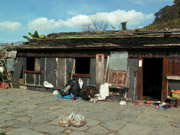
Since it was getting late we raced our way home. No one spoke because we were so tired. After walking hard for almost an hour we arrived at the parking lot. We recovered our talkative mood in the car while it rocked all the way back to Old Paiwan. It was already 4pm and after resting a bit in Uncle A-de’s house we slept our way down. At 5:30pm we arrived home. Thinking back, although it was very tiring that day, but what we learnt will last us a lifetime. Tonight I surely will sleep till daylight; hopefully I will get up tomorrow.
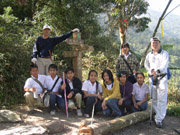
Top |
